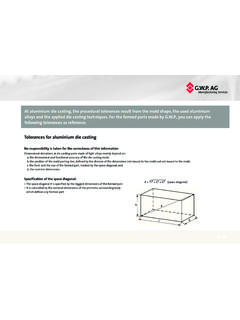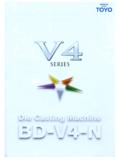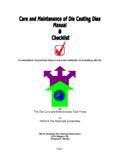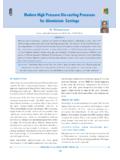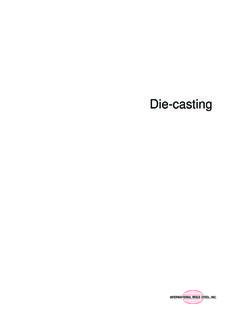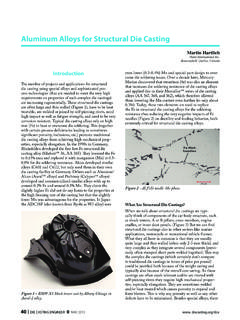Transcription of Casting - moderneq.com
1 Timothy GutowskiCasting since about 4000 Greece; bronzestatue Casting circa 450 BCIron works in early Europe, cast iron cannons fromEngland circa 1543 Outline Sand Casting , Investment Casting , Die Casting Basics and countermeasures Phase Change, Shrinkage Heat Transfer Pattern Design Variations & Developments Environmental IssuesCastingReadings; , Chapters 10, 11, , Design for Die Casting Heat Flow in Solidification Note: a good heat transfer reference can be found by Prof John Lienhard Methods Sand CastingHigh Temperature Alloy, Complex Geometry, Rough Surface Finish Investment CastingHigh Temperature Alloy, Complex Geometry, Moderately Smooth Surface Finish Die CastingHigh Temperature Alloy, Moderate Geometry, Smooth SurfaceSand CastingSand CastingDescription: Tempered sand is packed into wood or metal pattern halves, removed form the pattern, and assembled with or without cores, and metal is poured into resultant cavities.
2 Various core materials can be used. Molds are broken to remove castings. Specialized binders now in use can improve tolerances and surface : Most castable Range: Limitation depends on foundry capabilities. Ounces to many :Non-Ferrous 1/32 to 6 Add .003 to 3 , 3/64 from 3 to 6 .Across parting line add .020 to .090 depending on size. (Assumes metal patterns)Surface Finish:Non-Ferrous: 150-350 RMSF errous: 300-700 RMSM inimum Draft Requirements:1 to 5 Cores: 1 to 1 1/2 Normal Minimum Section Thickness:Non-Ferrous: 1/8 -1/4 Ferrous: 1/4 -3/8 Ordering Quantities: All quantitiesNormal Lead Time:Samples: 2-10 weeksProduction 2-4 weeks Casting Mold FeaturesVents, which are placed in molds to carry off gases produced when the molten metal comes into contact with the sand in the molds and core. They also exhaust air from the mold cavity as the molten metal flows into the Video from Mass FoundryProduction sand castingThe investment- Casting process, also called the lost-waxprocess, was first used during the period 4000-3500 The pattern is made of wax or a plastic such as polystyrene.
3 The sequences involved in investment Casting are shown in Figure The pattern is made by injecting molten wax or plastic into a metal die in the shape of the CastingInvestment CastingDescription: Metal mold makes wax or plastic replica. There are sprued, then surrounded with investment material, baked out, and metal is poured in the resultant cavity. Molds are broken to remove the : Most castable Range: fraction of an ounce to 150 : .003 to 1/4 .004 to 1/2 , .005 per inch to 3 .003 for each additional inchSurface Finish:63-125 RMSM inimum Draft Requirements: NoneNormal Minimum Section Thickness:.030 (Small Areas).060 (Large Areas)Ordering Quantities: Aluminum: usually under 1,000 Other metals: all quantitiesNormal Lead Time:Samples: 5-16 weeks (depending on complexity)Production 4-12 weeks (depending on subsequent operations).Talbot Associates Casting Cold-Chamber CastingCycle in cold-chamber Casting : (1) with die closed and ram withdrawn, molten metal is poured into the chamber; (2) ram forces metal to flow into die, maintaining pressure during the cooling and solidification; and (3) ram is withdrawn, die is opened, and part is ejected.
4 Used for higher temperature metals eg Aluminum, Copper and alloysDie Casting Hot-Chamber CastingCycle in hot-chamber Casting : (1) with die closed and plunger withdrawn, molten metal flows into the chamber; (2) plunger forces metal in chamber to flow into die, maintaining pressure during cooling and solidification; and (3) plunger is withdrawn, die is opened, and solidified part is ejected. Finished part is shown in (4).Die CastingDescription: Molten metal is injected, under pressure, into hardened steel dies, often water cooled. Dies are opened, and castings are : Aluminum, Zinc, Magnesium, and limited Range: Not normally over 2 feet square. Some foundries capable of larger :Al and Mg .002 .0015 /in. Brass .001 .001 to .015 across parting line depending on sizeSurface Finish: 32-63 RMSM inimum Draft Requirements: Al & Mg: 1 to 3 Zinc: 1/2 to 2 Brass: 2 to 5 Normal Minimum Section Thickness:Al & Mg: .03 Small Parts: .06 Medium Parts Zinc.
5 03 Small Parts: .045 Medium Parts Brass: .025 Small Parts: .040 Medium Parts Ordering Quantities: Usually 2,500 and Lead Time:Samples: 12-20 weeks Production: ASAP after Melt Temperature Chemical Activity High Latent Heat Handling Off-gassing3000 C0 C1000 C2000 CTungsten Carbide, WC, Silicon Carbide, SiCMolybdenumAlumina Al2O3 Platinum, PtTitanium, TiIronFE, Plain Carbon Steels, low alloy, stainlessNickel, NiNickel AllowsCubic Zirconia, ZrO2 Silicon, SiCopper, Cu, Bronze, BrassAluminumMagnesiumZinc, ZnPTFE (Teflon)Tin, SnHDPEN ylonAcetalMold FillingBernouli s Equation:Reynold s Number: Short filling times Potential Turbulence(see p. 273 .. ++ vDP=RehMold Filling Example(1 of 2)Mold Filling Example(2 of 2)PhaseChange &ShrinkageSolidification of a binary alloyComposition change during solidificationSolidificationCast structuresSchematic illustration of three cast structures solidified in a square mold: (a) pure metals; (b) solid solution alloys; and structure obtained by using nucleating agents.)
6 Source: G. W. Form, J. F. Wallace, and A. CibulaPop quiz; If you top fill the mold below, what will the part look like after solidification?Can you explain these features?Heat Transfer Sand Casting2 AVtsHeat Transfer Die Casting1 AVtsSteady State Conduction Heat TransferFigure 1 Steady State Conduction Heat TransferFigure 2 Thermal Conductivity k of Various Materials for Parts and Molds (W/m K) =Film Coefficients W/m2 KTypical die casting5,000 Natural convection1 - 10 Flowing air10 - 50()Thq =Transient Heat TransferSand Casting (see Flemings)Sand Casting (see Flemings)Solidification TimeenthapyUse Flemingsresult hereSolidification Time (cont.)Cooling Time; thin slabCooling time;intersection +=112112hLhAVPattern Design suggestionsMore PatternDesignsuggestionsAnd outside bosses and the need for cores.(Courtesy of Meehanite Metal Corp.)Figure using ribs which meet at acute angles.(Courtesy of Meehanite Metal Corp.)Die Casting SolidificationTimesTime to form solid partATime to cool part to the ejection temperature.
7 (lumped parameter model) mCpdTdt= Ah T To()let =T To = tftipdtmCAhdif i= Ti + Tsp-Tmold Tsp= H/Cp f= Teject-Tmoldt= mCpAhln f iIntegration t=w Cp2hlnTinject+ Tsp TmoldTeject Tmold Or for thin sheets of thickness w , sp means superheatPattern Design Issues (Alum) Shrinkage Allowance .013/1 Machining Allowance 1/16 Minimum thickness3/16 Parting Line Draft Angle 3 to 5% Uniform ThicknessPattern DesignTable Shrinkage Allowance for Some Metals Cast in Sand MoldsMetalPercentGray cast cast cast and Developments Continuous Casting Lost foam molding 3D Printing of Investment tooling Direct printing with metal droplets Uniform metal sprayContinuous Casting ref AISIS teel from the electric or basic oxygen furnace is tapped into a ladle and taken to the continuous Casting machine. The ladle is raised onto a turret that rotates the ladle into the Casting position above the tundish.
8 Referring to Figure 2,liquid steel flows out of the ladle (1) into the tundish (2), and then into a water-cooled copper mold (3). Solidification begins in the mold, and continues through the First Zone (4) and Strand Guide (5). In this configuration, the strand is straightened (6), torch-cut (8), then discharged (12) for intermediate storage or hot charged for finished rolling. 3D Printingof Investment cast toolingSpread PowderLayer Print Selected Area Lower Piston Completed PartsLast Layer PrintedShell and part (Turbine blade)Microcasting of dropletsCMUMITE nvironmental Issues Energy Materials Emission Off-gassing see AFS webpage on green sand emissions; Material FlowMetals Flow Sand+ FlowPouringCoolingTrimShakeoutMixingProd uct FinishingMeltingMold FormationSand CoolingSand Processing (AO Treatment)RecyclingRecyclingProduct & WasteLossesA. JonesSand Casting ; boundariesS. DalquistSand Casting ; energy profile National statistics averages 6 to 12 MJ/kg (at the factory) of saleable cast metal Melting largest componentS.
9 DalquistNat l statistics Vs model pour Vs part size ~ 2 to 3 thermal energy H = mCp T+m Hf=> (aluminum), MJ/kg (cast iron) furnace efficiency, < < melt energy 3 to 6(model) Vs to (statistics) Casting Energy at preparationSource: DOE, : EIA, & sand used in Casting Iron accounts for 3/4 of US sand cast metals Similar distribution in the UK Share of aluminum expected to increase with lightweighting of automotive parts Sand used to castings out about :1 by mass Sand lost about :1 in US; :1 in UKSource: DOE, sand Casting %715115 + =kgMJhTCpII reduce pour size improve furnace efficiency use waste heat use fuel Vs electricityAggregate TRI data (toxic releases) Sandcasting Emissions Factors Emissions factors are useful because it is often too time consuming or expensive to monitor emissions from individual sources. They are the best way to estimate emissions if you do not have test data. *S= % of sulfur in the coke.
10 Assumes 30% conversion of sulfur into : EPA AP-42 Series Iron Foundries - Induction * LeadSO2 COTotal ParticulateProcessIron Melting Furnace Emissions Factors (kg/Mg of iron produced)Source:AFS Organic HAP Emissions Factors for Iron Foundries average average heavily coredEmissions FactorCore LoadingPouring, Cooling Shakeout Organic HAP EmissionsFactors for Cored Greensand Molds (lbs/ton of iron produced)TRI Emissions Data 2003 XYZ Foundry (270,000 tons poured)262,191262,11774074 ZINC (FUME OR DUST)1,152,8891,145,5857,300 TOTALS7,4848356,64556, ,709768,38732248274 MANGANESE39,69239,52516740127 LEAD2020000 DIISOCYANATES74,77874,70178969 COPPERT otal wasteManaged (lbs)Total transfers offsite for wasteManagement (lbs)Total on-siteRelease (lbs)SurfaceWaterDischarge (lbs)Total AirEmissions (lbs)ChemicalReadings G. Boothroyd et al., "Design for Die Casting " Flemings, "Solidification Process" Kalpakjian Ch 10-12, Skim Sec , , Skim Ch 32 (Ch 10-12, Skim Ch 29, 30) Dalquist, "Life Cycle Analysis of Conventional Manufacturing Techniques: Sand Casting ,"



